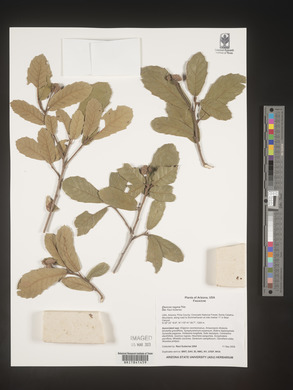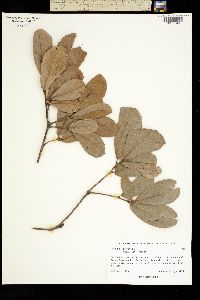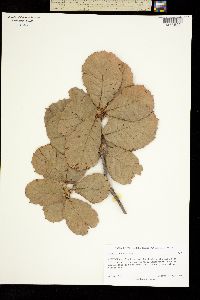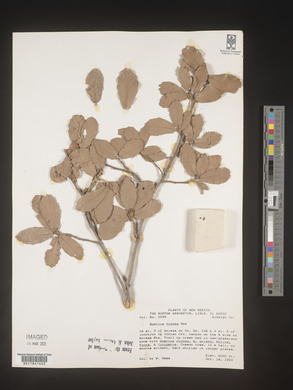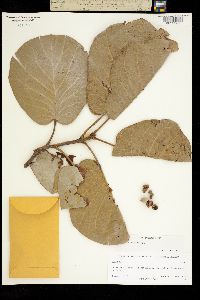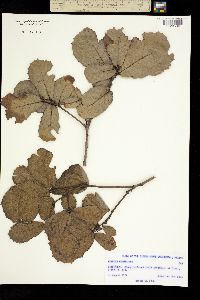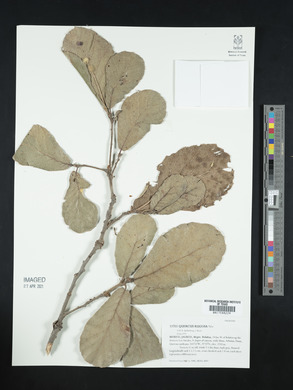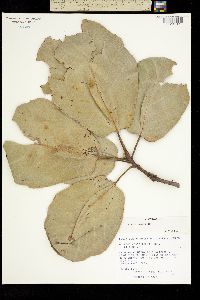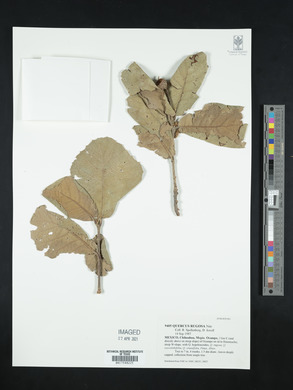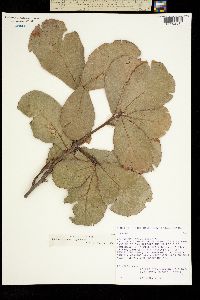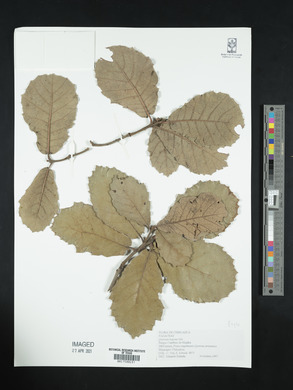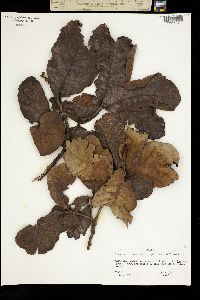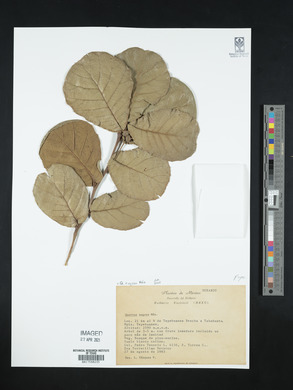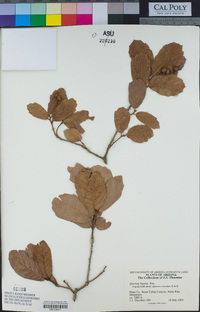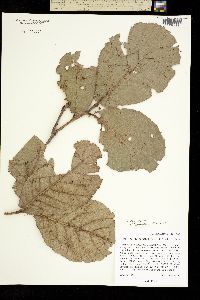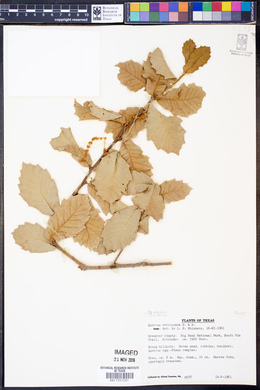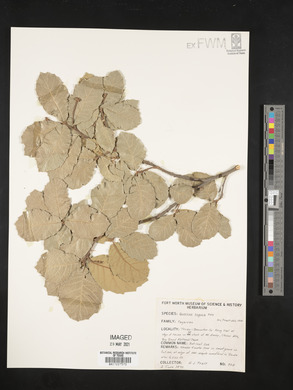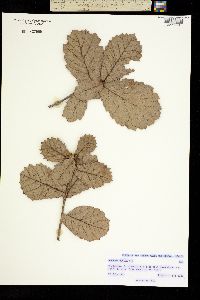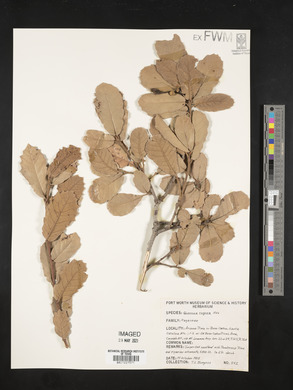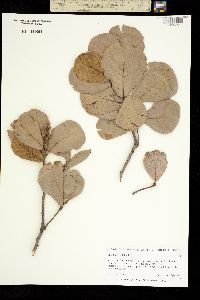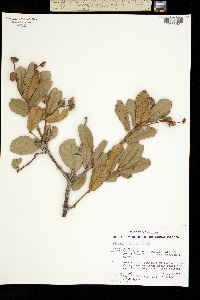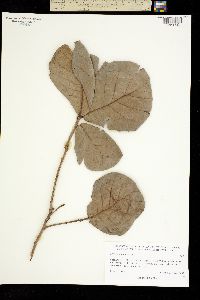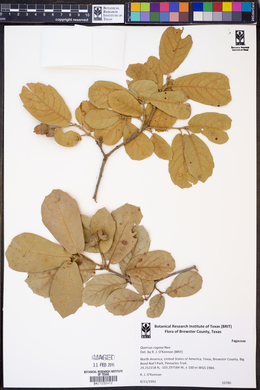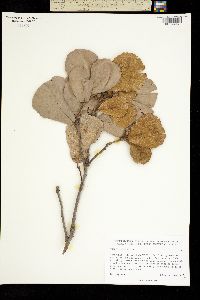Quercus rugosa
|
|
|
|
Family: Fagaceae
netleaf oak, more...Rugosa Oak (es: encino blanco, encino, encino de asta)
[Quercus diversicolor Trel., moreQuercus diversicolor var. mearnsii Trel., Quercus dugesii , Quercus innuncupata , Quercus purpusii Trel., Quercus reticulata Humb. & Bonpl., Quercus rhodophlebia , Quercus rhodophlebia f. applanata Trel., Quercus rhodophlebia f. concava Trel., Quercus rhodophlebia f. crenata Trel.] |
Shrubs or trees , evergreen, usually moderate-sized, rarely large. Bark light or dark brown, scaly. Twigs brown, turning gray with age, 1-2 mm diam., tomentose to tomentulose, variously glabrate or persistently pubescent. Buds brown, ovoid, 2-4 mm, apex obtuse, sparsely pubescent or eventually glabrate. Leaves: petiole to 7 mm. Leaf blade broadly obovate or panduriform to orbiculate or elliptic, rarely narrowly obovate, usually cupped, strongly concave proximally, sometimes planar, to 100 × 70 mm, stiff, leathery, base deeply or shallowly cordate, margins usually somewhat revolute, cartilaginously thickened, undulately crisped or flat with inconspicuous or coarse mucronate teeth near apex, secondary veins 8-10(-12) on each side, branched, apex broadly rounded, rarely subacute; surfaces abaxially dull, glaucous, or densely brownish tomentose, becoming nearly glabrate or pubescence persistent, especially about midribs, secondary veins very prominently raised, reticulate, adaxially dark green, lustrous, sparsely stellate-pubescent especially about base of midrib, secondary veins impressed. Acorns 1-3 or more on slender axillary peduncle 30-60 mm; cup deeply cup-shaped to saucer-shaped, to 9 mm deep × 15 mm wide, enclosing to 1/2 nut, scales loosely appressed, characteristically somewhat spreading, brown, ovate, tuberculate-thickened or only slightly so, tomentose or obscurely tomentulose; nut light brown, ovoid to elliptic, to 20 × l5 mm, glabrous or minutely villous. Cotyledons distinct, often reddish or purple. Flowering early-late spring. Wooded slopes; 2000-2500 m; Ariz., N.Mex., Tex.; Mexico; Central America (Guatemala). Quercus rugosa occurs on wooded slopes at high elevations in trans-Pecos Texas, southern New Mexico, and Arizona, and throughout most of the mesic montane parts of Mexico, south to Guatemala.
Plant: tree; to 10 m high, the bark light gray, relatively thin, with many longitudinal fissures between narrow plates; young twigs densely yellowish woolly to scarcely pubescent, reddish-brown with lighter lenticels beneath the hairs, the older twigs glabrescent within about 2 years, becoming grayish, remaining more or less smooth Leaves: unlobed, obovate, oblanceolate, or less often elliptic, 2-10 cm long, 1.5-7 cm wide, 1.3-2.5 times as long as wide, densely to scarcely covered with stellate and glandular hairs beneath, persisting about 1 year; stellate hairs of lower leaf surface with 6-11 arms; apex rounded to acute; base cordate to obtuse; petiole 2-5 mm long, usually densely woolly, less often subglabrous; midvein impressed (although often convex) above, prominent below; lateral veins 6-10 pairs, impressed and distinct above, prominent below; secondary veins impressed slightly or flat above, raised below; blade coriaceous, slightly lustrous or dull above, often golden yellow below because of glandular hairs, often concave beneath; margin slightly to strongly revolute, with 3-9, somewhat mucronate teeth INFLORESCENCE: staminate flowers in aments; pistillate flowers solitary or in groups on spikes, these sometimes abbreviated, each pistillate flower with a separate involucre Flowers: mostly wind-pollinated, unisexual, the perianth much reduced or absent; staminate flowers in heads or aments, the perianth greenish, the stamens 3-6; pistillate flowers usually tricarpellate, solitary or in clusters of about 3 or more, subtended individually or in groups by an involucre that develops into a woody cupule enclosing or subtending the mature fruit(s) Fruit: ACORNS 1.5-2 cm long, usually 2-4 on peduncles 1.5-6.3 cm long; cap hemispheric to deep-bowl shaped, 4-10 mm long, 10-16 mm wide, finely appressed yellowish or reddish pubescent to woolly within; scales with thickened bases; nut-shell subglabrous within or with pubescent apex and base Misc: In oak and conifer forests; 1500-2700 m (5000-9000 ft); Apr-Jun (fr. Sep) REFERENCES: Landrum, Leslie R. Fagaceae. 1994. J. Ariz. - Nev. Acad. Sci. Volume 27, 203-214 Landrum 1993, Martin and Hutchins 1980 Common Name: netleaf oak Duration: Perennial Nativity: Native Lifeform: Tree Wetland Status: FAC General: Shrubs and trees to 10 m high, bark light gray, relatively thin, with many longitudinal fissures between plates, young twigs densely yellowish woolly to scarcely pubescent, reddish-brown with lighter lenticels beneath hairs, older twigs glabrescent within about 2 years, becoming grayish. Leaves: Unlobed, obovate, oblanceolate, or elliptic, 2-10 cm long, 1.5-7 cm wide, 1.3-2.5 times as long as wide, densely to scarcely covered with stellate and glandular hairs beneath; persisting about 1 year; apex rounded to acute, base cordate to obtuse, petiole 2-5 mm long; midvein prominent below; leathery, dull green above, golden yellow below, margin slightly revolute, 3-9 teeth. Flowers: Wind pollinated staminate aments, with reduced perianth parts, 3-6 stamens. Fruits: Acorns 1.5-2 cm long, usually 2-4 on peduncles 1.5-6.3 cm long, cap hemispheric to deep-bowl shaped, 4-10 mm long, 10-16 mm wide, finely appressed yellowish or reddish pubescent to woolly within; scales with thickened bases. Ecology: Found in oak and conifer forests, often on wooded slopes from 5,000-9,000 ft (1524-2743 m); flowers April-June. Notes: Distinctive in its thicket-forming habit, with long leaves, often with the mature leaves gaining a golden yellow color beneath the larger leaves. Ethnobotany: Unknown, but other species in the genera have many uses. Etymology: Quercus is the classical Latin word for oak, thought to be derived from Celtic quer, fine, and cuez, tree, while rugosa means wrinkled. Synonyms: Quercus diversicolor, Q. reticulata Editor: SBuckley, 2010 |
|
|
|































